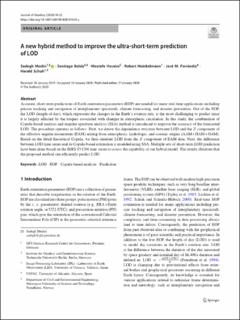| dc.contributor.author | Modiri, Sadegh | |
| dc.contributor.author | Belda, Santiago | |
| dc.contributor.author | Hoseini, Mostafa | |
| dc.contributor.author | Heinkelmann, Robert | |
| dc.contributor.author | Ferrandiz, Jose M | |
| dc.contributor.author | Schuh, Harald | |
| dc.date.accessioned | 2021-06-03T08:31:16Z | |
| dc.date.available | 2021-06-03T08:31:16Z | |
| dc.date.created | 2020-04-23T16:11:03Z | |
| dc.date.issued | 2020 | |
| dc.identifier.citation | Journal of Geodesy. 2020, 94 (2), 1-14. | en_US |
| dc.identifier.issn | 0949-7714 | |
| dc.identifier.uri | https://hdl.handle.net/11250/2757492 | |
| dc.description.abstract | Accurate, short-term predictions of Earth orientation parameters (EOP) are needed for many real-time applications including precise tracking and navigation of interplanetary spacecraft, climate forecasting, and disaster prevention. Out of the EOP, the LOD (length of day), which represents the changes in the Earth’s rotation rate, is the most challenging to predict since it is largely affected by the torques associated with changes in atmospheric circulation. In this study, the combination of Copula-based analysis and singular spectrum analysis (SSA) method is introduced to improve the accuracy of the forecasted LOD. The procedure operates as follows: First, we derive the dependence structure between LOD and the Z component of the effective angular momentum (EAM) arising from atmospheric, hydrologic, and oceanic origins (AAM + HAM + OAM). Based on the fitted theoretical Copula, we then simulate LOD from the Z component of EAM data. Next, the difference between LOD time series and its Copula-based estimation is modeled using SSA. Multiple sets of short-term LOD prediction have been done based on the IERS 05 C04 time series to assess the capability of our hybrid model. The results illustrate that the proposed method can efficiently predict LOD. | en_US |
| dc.language.iso | eng | en_US |
| dc.publisher | Springer Nature | en_US |
| dc.rights | Navngivelse 4.0 Internasjonal | * |
| dc.rights.uri | http://creativecommons.org/licenses/by/4.0/deed.no | * |
| dc.title | A new hybrid method to improve the ultra-short-term prediction of LOD | en_US |
| dc.type | Peer reviewed | en_US |
| dc.type | Journal article | en_US |
| dc.description.version | publishedVersion | en_US |
| dc.source.pagenumber | 1-14 | en_US |
| dc.source.volume | 94 | en_US |
| dc.source.journal | Journal of Geodesy | en_US |
| dc.source.issue | 2 | en_US |
| dc.identifier.doi | 10.1007/s00190-020-01354-y | |
| dc.identifier.cristin | 1807739 | |
| dc.description.localcode | Open Access This article is licensed under a Creative Commons Attribution 4.0 International License, which permits use, sharing, adaptation, distribution and reproduction in any medium or format, as long as you give appropriate credit to the original author(s) and the source, provide a link to the Creative Commons licence, and indicate if changes were made. The images or other third party material in this article are included in the article’s Creative Commons licence, unless indicated otherwise in a credit line to the material. If material is not included in the article’s Creative Commons licence and your intended use is not permitted by statutory regulation or exceeds the permitted use, you will need to obtain permission directly from the copyright holder. To view a copy of this licence, visit http://creativecommons.org/licenses/by/4.0/. | en_US |
| cristin.ispublished | true | |
| cristin.fulltext | original | |
| cristin.qualitycode | 1 | |

